
Regionalism - I
Regionalism
American Regionalism is an American realist modern art movement that included paintings, murals, lithographs, and illustrations depicting realistic scenes of rural and small-town America primarily in the Midwest. It arose in the 1930s as a response to the Great Depression, and ended in the 1940s due to the end of World War II and a lack of development within the movement. It reached its height of popularity from 1930 to 1935, as it was widely appreciated for its reassuring images of the American heartland during the Great Depression. Despite major stylistic differences between specific artists, Regionalist art in general was in a relatively conservative and traditionalist style that appealed to popular American sensibilities, while strictly opposing the perceived domination of French art.
Winslow Homer
1836 – 1910
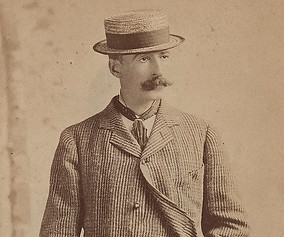
Winslow Homer (February 24, 1836 – September 29, 1910) was an American landscape painter and illustrator, best known for his marine subjects. He is considered one of the foremost painters in 19th-century America and a preeminent figure in American art.
Largely self-taught, Homer began his career working as a commercial illustrator. He subsequently took up oil painting and produced major studio works characterized by the weight and density he exploited from the medium. He also worked extensively in watercolor, creating a fluid and prolific oeuvre, primarily chronicling his working vacations.

Winslow Homer - Croquet Scene, 1866

Winslow Homer - Dad's Coming!, 1873
_-_Google_Art_Project.jpg)
Winslow Homer - Breezing Up (A Fair Wind). 1873–76

Winslow Homer - The Four Leaf Clover, 1873

Winslow Homer - Peach Blossoms, 1878

Winslow Homer - The Life Line, 1884

Winslow Homer - Shark Fishing, 1885

Winslow Homer - The Gulf Stream, 1899

Winslow Homer - "After The Hurricane" 1899
Frank Benson
1862 – 1951
Frank Weston Benson
Frequently referred to as Frank W. Benson, (March 24, 1862 – November 15, 1951) was an American artist from Salem, Massachusetts known for his Realistic portraits, American Impressionist paintings, watercolors and etchings. He began his career painting portraits of distinguished families and murals for the Library of Congress. Some of his best known paintings (Eleanor, Museum of Fine Arts, Boston; Summer, Rhode Island School of Design Museum) depict his daughters outdoors at Benson's summer home, Wooster Farm, on the island of North Haven, Maine. He also produced numerous oil, wash and watercolor paintings and etchings of wildfowl and landscapes.
In 1880, Benson began to study at the School of the Museum of Fine Arts, Boston under both Otto Grundmann and Frederic Crowninshield. In 1883 he travelled to Paris to study at the Académie Julian.[2] He enjoyed a distinguished career as an instructor and department head at the School of the Museum of Fine Arts, Boston. He was a founding member of the Ten American Painters, American Academy of Arts and Letters and The Guild of Boston Artists.
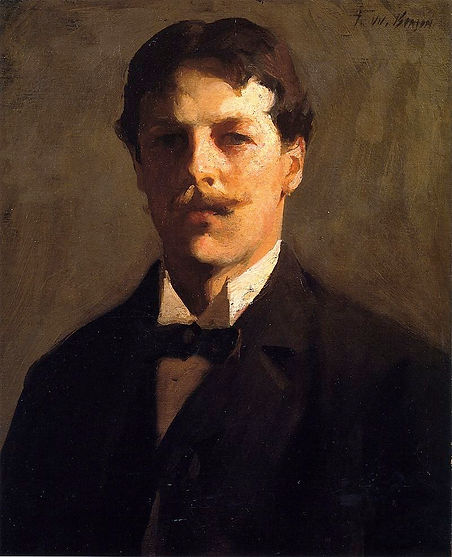
Frank Benson. Self-Portrait

Frank Benson. Summer (1909)

Frank Benson. Portrait of My Wife, 1889

Frank Benson. Moonlight on the Waters oil 1899
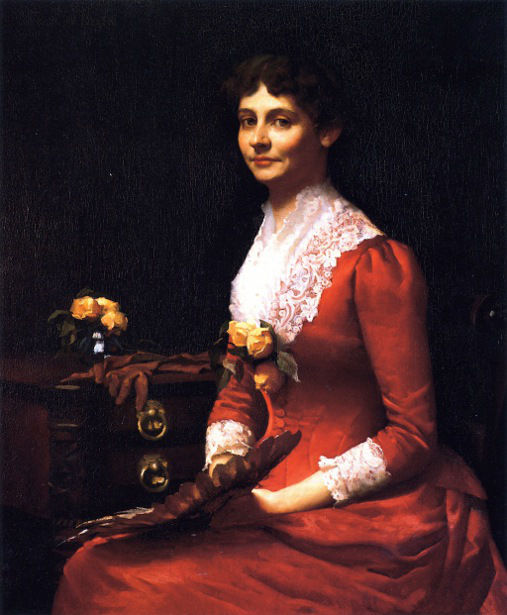
Frank Benson. Portrait of Margaret Washburn, 1886

Frank Benson. Red and Gold, portrait of countess Clelia de Candia, 1915

Frank Benson.The Sisters, 1899

Frank Benson. Eleanor Holding a Shell, 1902

Frank Benson. Eleanor, 1907

Frank Benson. Summer, 1909

Frank Benson. Elizabeth and Ann, c.1909

Frank Benson. Margaret Gretchen Strong, 1909

Frank Benson. Playing Solitaire oil 1909

Frank Benson. The Reader, portrait of countess Cecilia Maria de Candia, ca. 1910

Frank Benson. Against the Sky, ca. 1912
Albert Herter
1871 – 1950

Albert Herter
(March 2, 1871 – February 15, 1950) was an American painter, illustrator, muralist, and interior designer. He was born in New York City, studied at the Art Students League with James Carroll Beckwith, then in Paris with Jean-Paul Laurens and Fernand Cormon.
He came from an artistic family; his father, Christian Herter (1839–1883), had co-founded Herter Brothers, a prominent New York interior design and furnishings firm. Herter Brothers closed in 1906, and Albert founded Herter Looms in 1909, a tapestry and textile design-and-manufacturing firm that was, in a sense, successor to his father's firm.
In Paris, he met a fellow American art student, Adele McGinnis. They were married in 1893 and had three children: Everit Albert (1894–1918), Christian Archibald (1895–1966), and Lydia Adele (1898–1951). The couple honeymooned in Japan, then returned to Paris for the first years of their marriage. In 1898 they moved back to the United States and built a Mediterranean-style villa, called "Près Choisis" (later called "The Creeks"), in East Hampton, New York, with a studio for each of them. Herter's mother built a mansion, "El Mirasol," in Santa Barbara, California, where the family spent the winters. Following his mother's death, Herter and his wife renovated the mansion and converted it into a boutique hotel. Son Everit and daughter Lydia also became artists although Everit was killed at age 24 in World War I. Son Christian became a politician, serving as governor of Massachusetts and later U.S. Secretary of State under Dwight D. Eisenhower. Adele Herter was a founding member of New York City's Cosmopolitan Club, and is remembered as a painter of still lifes and "Society" portraits.

Albert Herter
Portrait of a Distinguished Lady in Her Garden
1919

Albert Herter
Woman with Red Hair (1894)

Albert Herter
Garden of the Hesperides (c.1898)

Albert Herter
A Family Group (c.1898)

Albert Herter
Judgment of Paris

Albert Herter
Portrait of Bessie (Miss Elisabeth Newton) 1892

Albert Herter
A Venetian

Albert Herter
The Roman Baths 1895
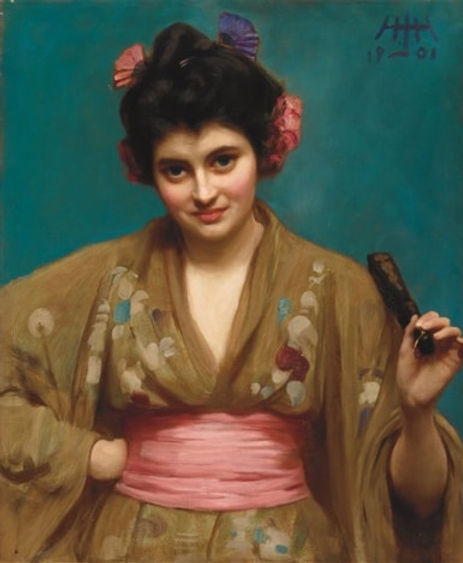
Albert Herter
Woman Wearing a Kimono

Albert Herter
Eastern Blossoms (also known as Geisha Standing on a Balcony) 1894
Howard Christy
1872 – 1952
Howard Christy
Howard Chandler Christy (January 10, 1872 – March 3, 1952) was an American artist and illustrator. Famous for the "Christy Girl" – a colorful and illustrious successor to the "Gibson Girl" – Christy is also widely known for his iconic WWI military recruitment and Liberty loan posters, along with his 1940 masterpiece titled, Scene at the Signing of the Constitution of the United States, which is installed along the east stairwell of the United States Capitol.
From the 1920s until the early 1950s, Christy was active as a portrait painter whose sitters included presidents, senators, industrialists, movies stars, and socialites. He painted Lt. Col. Theodore Roosevelt, and Presidents Warren G. Harding, Calvin Coolidge, Herbert Hoover, Franklin Delano Roosevelt, and Harry Truman. Other famous people he painted include William Randolph Hearst, the Prince of Wales (Edward VIII), Eddie Rickenbacker, Benito Mussolini, Prince Umberto, and Amelia Earhart. By 1938, Time magazine proclaimed Christy "the most commercially successful U.S. artist."

Howard Chandler Christy. Self-Portrait with Model

Howard Chandler Christy. Halloween (1915)

Howard Chandler Christy. Official portrait of First Lady Grace Coolidge, 1924

Howard Chandler Christy. Happy Motoring (The Happy Ending) 1919

Howard Chandler Christy. On A Sand Dune, 1934

Howard Chandler Christy. Nude Wearing Pearls

Howard Chandler Christy. Nymphs in Summer, 1946

Howard Chandler Christy. Girl in Forest

Howard Chandler Christy. Gee I wish I were a Man, I'd Join the Navy, 1917

Howard Chandler Christy. AMERICANS ALL! VICTORY LIBERTY LOAN

Howard Chandler Christy. Fly for Her Liberty. 1943.

Howard Chandler Christy. Nudes

Howard Chandler Christy. Reclining Nude

Howard Chandler Christy. Reclining Nude.

Howard Chandler Christy. Nude with Jug.

Howard Chandler Christy. Pocahontas , 1926

Howard Chandler Christy. Elise, 1929

Howard Chandler Christy. Nude

Howard Chandler Christy. An Elegant Nude, 1934

Howard Chandler Christy. Triptych of Three Nudes, Hunting, Fencing, and Tambourine

Howard Chandler Christy. Nude on a Sofa, 1933

Howard Chandler Christy. Nude with Cat

Howard Chandler Christy. In the Garden of Eden 1925
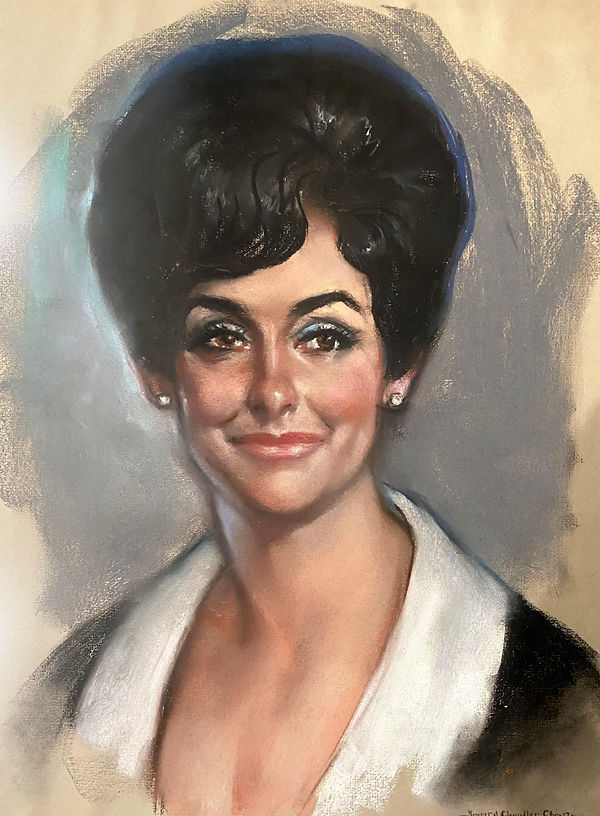
Howard Chandler Christy. Portrait
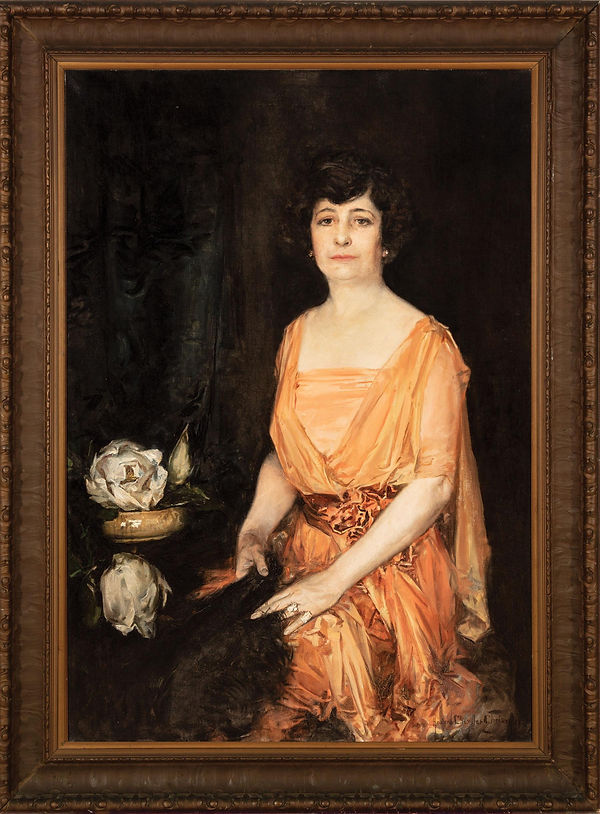
Howard Chandler Christy. Portrait
Everett Shinn
1876 – 1953
Everett Shinn
(November 6, 1876 – May 1, 1953) was an American painter and member of the urban realist Ashcan School.
Shinn started as a newspaper illustrator in Philadelphia, demonstrating a rare facility for depicting animated movement, a skill that would, however, soon be eclipsed by photography. Here he worked with William J. Glackens, George Luks and John Sloan, who became core-members of the Ashcan School, led by Robert Henri, which defied official good taste in favour of robust images of real life. Shinn is best known for scenes of disaster or street violence, as well as theatrical subjects, regarding the theatre as a place of satisfying illusion. Shinn was the only Ashcan artist who preferred to work in pastels. He was reportedly a model for the protagonist of Theodore Dreiser's novel The "Genius".

Self-Portrait
Everett Shinn
1901

Spanish Music Hall
Everett Shinn
1902

The White Ballet
Everett Shinn
1904

Concert Stage
Everett Shinn
1905

Keith’s Union Square
Everett Shinn
c.1902 - 1906

A French Music Hall
Everett Shinn
1906

Dancer in White Before the Footlights
Everett Shinn
1910

Fifth Avenue
Everett Shinn
1910
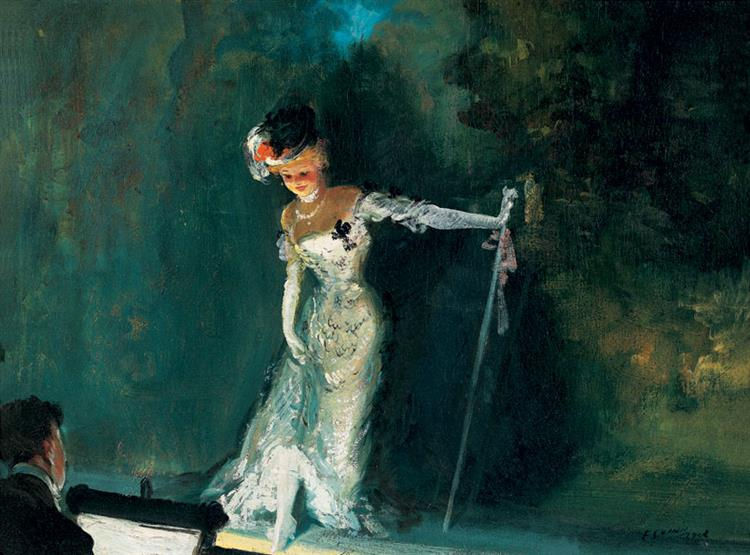
Revue
Everett Shinn
1903

Cross Streets of New York
Everett Shinn
1899

The Canfield Gambling House, 1912
Everett Shinn

Everett Shinn
Rehearsal of the Ballet, 1903
Edward Hopper
1882 - 1967
Edward Hopper
born July 22, 1882, Nyack, N.Y., U.S.
died May 15, 1967, New York City
U.S. painter whose realistic depictions of everyday urban scenes shock the viewer into recognition of the strangeness of familiar surroundings. He strongly influenced the Pop art and New Realist painters of the 1960s and 1970s.
Hopper was initially trained as an illustrator, but, between 1901 and 1906, he studied painting under Robert Henri, a member of a group of painters called the Ashcan School. Hopper travelled to Europe three times between 1906 and 1910, but he remained untouched by the experimental work then blossoming in France and continued throughout his career to follow his own artistic course. Although he exhibited paintings in the Armory Show of 1913, he devoted most of his time to advertising art and illustrative etchings until 1924. He then began to do such watercolours as “Model Reading” (1925; Art Institute of Chicago), as well as oil paintings. Like the painters of the Ashcan School, Hopper painted the commonplaces of urban life. But, unlike their loosely organized, vivacious paintings, his “House by the Railroad” (1925; Museum of Modern Art, New York City) and “Room in Brooklyn” (1932; Museum of Fine Arts, Boston) show still, anonymous figures and stern geometric forms within snapshot-like compositions that create an inescapable sense of loneliness. This isolation of his subjects was heightened by Hopper's characteristic use of light to insulate persons and objects in space, whether in the harsh morning light (“Early Sunday Morning,” 1930; Whitney Museum of American Art, New York City) or the eerie light of an all-night coffee stand (“Nighthawks,” 1942; Art Institute of Chicago).
Hopper's mature style was already formed by the mid-1920s.His subsequent development showed a constant refinement of his vision. Such late paintings as “Second-Story Sunlight” (1960; Whitney Museum of American Art, New York City) are distinguished by extremely subtle spatial relationships and an even greater mastery of light than is seen in his work of the 1920s.

Self-Portrait
1930

Room in Brooklyn

House by the Railroad

Cape Cod Evening
Edward Hopper
1939

Chop Suey

Gas
Edward Hopper
1940

Automata

Hotel Room

Eleven A.M.
1926

Caroina Morning

Morning in a City
Edward Hopper
1944

Morning Sun

Nighthawks

Soir Bleu
1914

Morning

New York Office

Compartment Car
Edward Hopper
1938

Girlie Show
Edward Hopper
1941

Summertime
Edward Hopper
1943

Summer Evening
Edward Hopper
1947

Second Story Sunlight
Edward Hopper
1960

Chair Car
Edward Hopper
1965
Arthur Carles
1882 – 1952
Arthur Carles
Arthur Beecher Carles (March 9, 1882 – 1952) was an American Modernist painter.
Carles was born in Philadelphia, Pennsylvania, and studied at the Pennsylvania Academy of the Fine Arts between 1900 and 1907. He studied with Thomas Pollock Anshutz, Hugh Breckenridge, Henry McCarter, Cecilia Beaux, and William Merritt Chase. In 1907 he traveled to France where he remained until 1910. In France, he greatly admired the works of Cézanne and Matisse, and became close friends with John Marin and Eduard Steichen. He displayed six landscapes in the Salon d'Automne of 1908.
In March 1910 his work was included in the “Younger American Painters” show held at Alfred Stieglitz’s New York City gallery, 291. Stieglitz gave Carles his first one-man show at 291 in January 1912.
He returned to France from June to October 1912 and exhibited at the 1912 Salon d'Automne. After his return to America he exhibited at the Armory Show of 1913. He taught at the Pennsylvania Academy in Philadelphia from 1917 to 1925 and taught privately afterwards. He continued a mentor relationship with many PAFA students through the 1930s, including the artist Norman Carton. His later years were marked by bouts of alcoholism. In December 1941 he suffered a stroke that left him an invalid until his death in 1952. His daughter Mercedes Matter, also an artist and the founder of the New York Studio School, was married to photographer and designer Herbert Matter.

Arthur Carles. Self Portrait

Frances Metzger West
Arthur Beecher Carles
1907

Silence
Arthur Beecher Carles
1908

Arthur Carles. City at Night. 1905

Arthur Carles. Reclining Nude, 1915-1921

Portrait of Katharine Rhoades
Arthur Beecher Carles
1912
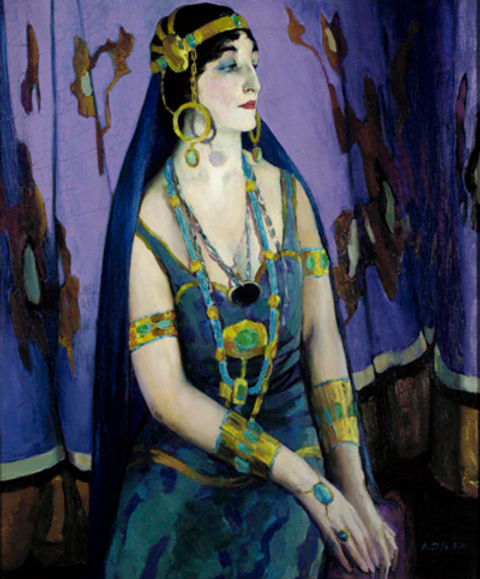
The Actress as Cleopatra (Mercedes de Cordoba, artist's wife)
Arthur Beecher Carles
1914

Woman in White
Arthur Beecher Carles
1920

Woman with Red Hair
Arthur Beecher Carles
1922

Composition (Seated Nude)
Arthur Beecher Carles
1935

Arthur Carles. Swinging Nude

Arthur Carles. TWO FEMALE NUDES

Arthur Carles. Abstract Landscape

Arthur Carles. LOUNGING NUDE

Arthur Carles. ANGÈLE

Arthur Carles. "After the Bath," ca. 1911

Arthur Carles. Nude with Red Background.

Arthur Carles. Untitled

Arthur Carles. Nude
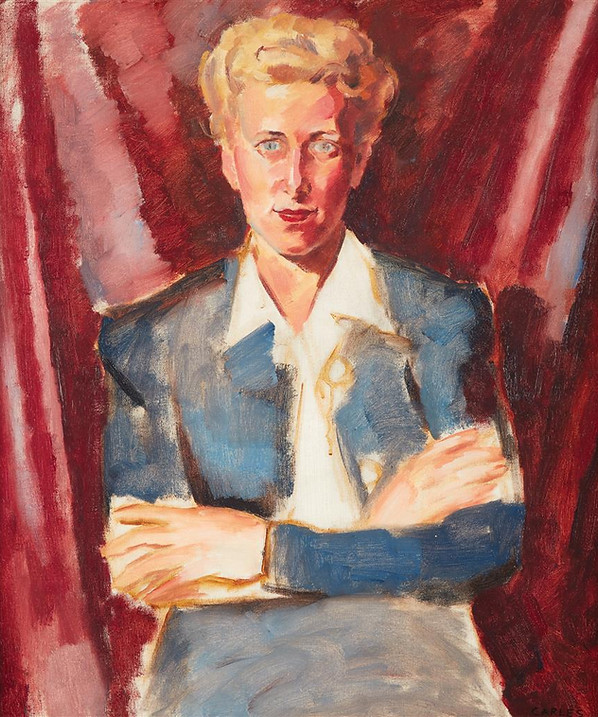
Arthur Carles. Portrait of Leopold Stokowski

Arthur Carles. Mlle de C.

Arthur Carles. NUDE LEANING

Arthur Carles. Semi Abstract Nude

Arthur Carles. RECLINING NUDE

Arthur Carles. NUDE

Arthur Carles.

Arthur Carles. RECLINING NUDE

Arthur Carles.

Arthur Carles.

Arthur Carles. RECLINING NUDE

Arthur Beecher Carles
Portrait of a Seated Woman, ca. 1925
Thomas Hart Benton
1889 – 1975
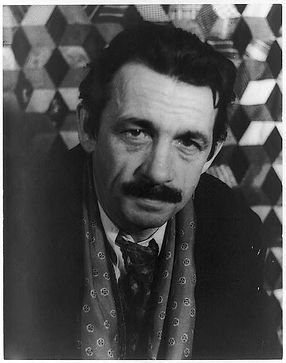
Thomas Hart Benton
(April 15, 1889 – January 19, 1975) was an American painter, muralist, and printmaker. Along with Grant Wood and John Steuart Curry, he was at the forefront of the Regionalist art movement. The fluid, sculpted figures in his paintings showed everyday people in scenes of life in the United States.
His work is strongly associated with the Midwestern United States, the region in which he was born and which he called home for most of his life. He also studied in Paris, lived in New York City for more than 20 years and painted scores of works there, summered for 50 years on Martha's Vineyard off the New England coast, and also painted scenes of the American South and West.
Benton was born in Neosho, Missouri, into an influential family of politicians. He had two younger sisters, Mary and Mildred, and a younger brother, Nathaniel.[4] His mother was Elizabeth Wise Benton and his father, Colonel Maecenas Benton, was a lawyer and four times elected as U.S. congressman. Known as the "little giant of the Ozarks", Maecenas named his son after his own great-uncle, Thomas Hart Benton, one of the first two United States Senators elected from Missouri. Given his father's political career, Benton spent his childhood shuttling between Washington, D.C., and Missouri. His father sent him to Western Military Academy in 1905–06, hoping to shape him for a political career. Growing up in two different cultures, Benton rebelled against his father's plans. He wanted to develop his interest in art, which his mother supported. As a teenager, he worked as a cartoonist for the Joplin American newspaper, in Joplin, Missouri.
With his mother's encouragement, in 1907 Benton enrolled at The School of The Art Institute of Chicago. Two years later, he moved to Paris in 1909 to continue his art education at the Académie Julian. His mother supported him financially and emotionally to work at art until he married in his early 30s. His sister Mildred said, "My mother was a great power in his growing up." In Paris, Benton met other North American artists, such as the Mexican Diego Rivera and Stanton Macdonald-Wright, an advocate of Synchromism. Influenced by the latter, Benton subsequently adopted a Synchromist style

America Today
Thomas Hart Benton American
1930–31

America Today
Thomas Hart Benton American
1930–31

America Today
Thomas Hart Benton American
1930–31

America Today
Thomas Hart Benton American
1930–31

America Today
Thomas Hart Benton American
1930–31

America Today
Thomas Hart Benton American
1930–31

America Today
Thomas Hart Benton American
1930–31

America Today
Thomas Hart Benton American
1930–31

America Today
Thomas Hart Benton American
1930–31

America Today
Thomas Hart Benton American
1930–31

Thomas Hart Bentonю Persephone

Thomas Hart Benton

Thomas Hart Benton

Thomas Hart Benton

Thomas Hart Benton

Thomas Hart Benton

July Hay
Thomas Hart Benton
1942
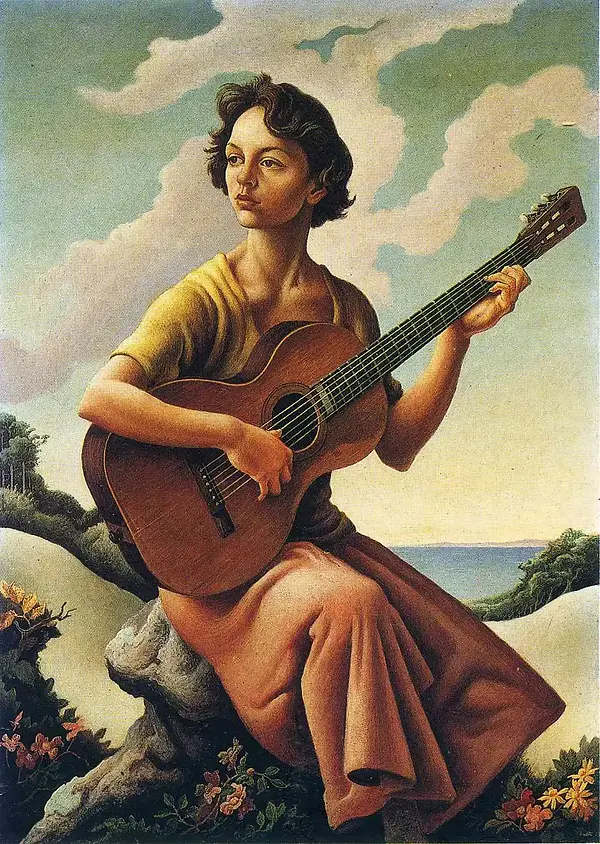
Thomas Hart Benton

Hollywood
Thomas Hart Benton
1937

Thomas Hart Benton
Grant Wood
1892-1942
Grant Wood
(1892-1942)
Grant Wood, an American painter, was a leader in the art movement known as Regionalism, which also included the artist Thomas Hart Benton. Wood was born in Iowa and lived mainly in Cedar Rapids. He visited Europe repeatedly from an early age and studied at the Academie Julian in Paris in 1933. Still, he was mainly self-taught as an artist: he worked as a camouflage painter during World War One, an interior decorator, and a metalworker. His early paintings were strongly influenced by French Impressionism. In 1928, having been commissioned to make stained-glass windows for the Cedar Rapids Veterans Memorial Building, he traveled to Munich to supervise the windows' production; there he encountered early Dutch painting, and was inspired to give up Impressionism in favor of his characteristic mature style. Under the influence of Memling and other early Netherlandish masters, Wood began painting with close attention to sharp, crisp detail. In the Regionalist aesthetic, the everyday lives of working people are the highest subjects of art; modern ideas of abstraction are often considered elitist and decadent. Wood therefore mainly depicted scenes of everyday Midwestern life in a fresh and sometimes stark manner. His best-known work, American Gothic (1930), won a bronze medal at an exhibition at the Art Institute of Chicago, but it caused controversy among some of the very people it was intended to depict, who interpreted the painting as broad, insensitive caricature. In the decades since, however, the work has become one of the most enduring images in American art. Wood painted many landscapes, as well as other scenes and portraits, including The Midnight Ride of Paul Revere (1931) and a genuinely satirical work, Daughters of the Revolution (1932). He supervised Federal Art Projects in Iowa and was assistant professor of fine arts at the University of Iowa.

Self-Portrait

GRANT WOOD: AMERICAN GOTHIC. 1930. Chicago. Art Institute

Grant Wood. Fall Plowing

Grant Wood. Spring in Town

Grant Wood. Daughters of the Revolution

Grant Wood. Stone City, Iowa 1930

Grant Wood. The Midnight Ride of Paul
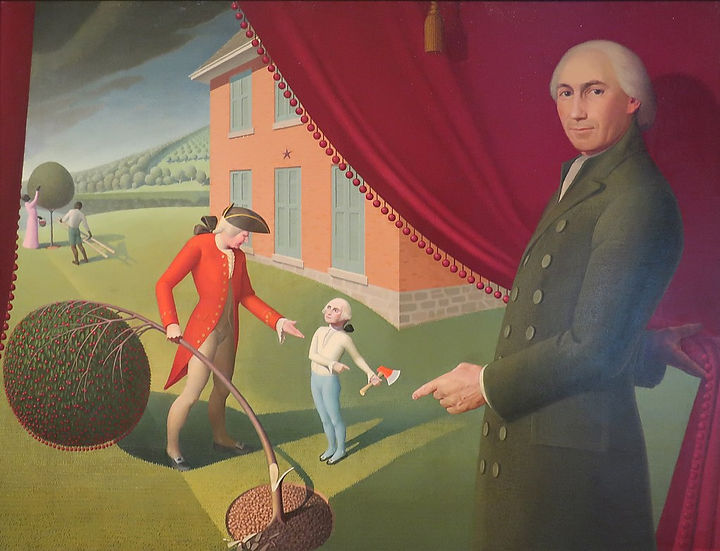
Grant Wood. Parson Weems' Fable